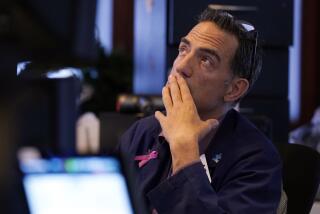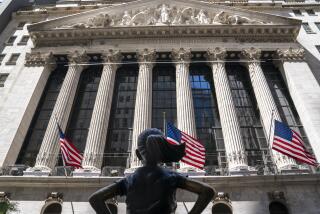AGING BULL : The Roar Is Still There, but Many Sound Warning: Watch Out for Bears
- Share via
As director of futures research for the Paine Webber brokerage, Jack Schwager has studied super bull markets in gold, sugar and other commodities over the years and contends that there is a consistent pattern in each of them. All such bull markets, he says, are followed by drastic bear markets.
And stocks, he contends, behave no differently.
“I’ve never seen any market make a major, explosive move up that has not been followed by an equally explosive decline,” Schwager says, predicting that stock prices will follow the collapse of gold prices, which, in the early 1980s fell more than 50% after rising eightfold to above $800 an ounce.
As the bull market is celebrated this week for what most analysts call its fifth anniversary Thursday, some market watchers like Schwager are comparing it to other bull markets and historical precedent in general, seeking clues to how long it will last, how much higher it will go and what will happen when it ends.
But while the 245% rise in the Dow Jones average of 30 industrial stocks since Aug. 13, 1982, has been remarkable and is expected to continue, the long-term future is not so comforting, these experts say. Many of today’s market conditions, they say, resemble those in several sharp bull markets--particularly in the 1920s and early 1970s--that were followed by sharp, dramatic bear markets.
If history repeats itself, stocks could be due for a sharp and painful drop, although it may not happen soon, these prognosticators say.
The similarities to the 1920s and early 1970s suggest that “when the next bear market comes, it’s going to be a humdinger,” says Charles I. Clough Jr., chief investment strategist for the Wall Street firm of Merrill Lynch.
Of course, no one knows what will actually happen. Many dismiss the idea of a sharp drop, or at least one that would resemble the disastrous crash of 1929-32, when the Dow index lost nearly 90% of its value.
And, by several historical standards, the market still has room to go much higher.
Since bottoming out at 776.92 five years ago, the Dow index has more than tripled, closing Tuesday at 2,680.48, up 44.64 points following a 43.84-point surge Monday. But that rise--while impressive--still keeps this bull market far short of the record 497% rise by the 1921-29 super bull market. During another impressive bull market, from 1949 to 1956, the Dow index rose 222%.
Also, the current market’s rise is less impressive when adjusted for inflation. The Dow index still needs to add about 100 points just to equal its January, 1973, high of 1,051.70, adjusted for inflation. Many of the blue-chip companies whose stocks make up the Dow index, such as General Motors, Eastman Kodak and Du Pont, actually have lower market values--what it would cost to buy all shares at their current price--than they did in 1965, even without adjusting for inflation.
Nonetheless, the bull market’s strength and longevity since 1982 has surprised and confounded many experts. Its headlong rush upward--fueled largely by foreign investment, lower interest rates and subdued inflation--has come despite a sluggish economy. Many sectors, such as energy and agriculture, have suffered economic depressions. “This market is remarkable in that it’s so sustained and keeps moving despite the fact that the economy doesn’t (justify) it,” says Lawrence A. Krause, president of a San Francisco financial planning firm.
The market has astounded experts for other reasons. Price-earnings ratios--which are stock prices divided by their earnings per share and are a key gauge of stock values--are close to 20 for stocks in the Dow industrial average. That level has historically signaled market tops. Yet stocks continue to barrel ahead with few signs of running out of gas.
The market has also chalked up its impressive gains despite a general lack of euphoria among investors. Indeed, many pension fund managers and other institutional investors remain skeptical and have maintained cash positions considered unusually high for this stage of a bull market, experts say.
Meanwhile, daily average trading volume on the New York Stock Exchange has more than doubled since 1982 (to more than 141 million shares in 1986 from 65 million in 1982). This added volume--attributed to the existence of more players in the market, trading more frequently--has boosted the liquidity of stocks.
That, in turn, has moderated the volatility of stock prices, experts say. Despite large swings on the Dow average, such as its 115-point fall during a 70-minute period on Jan. 23, the market is no more volatile than in the past, if price movements are figured on a percentage basis, many experts say.
The growing use by professional traders of stock-index futures, options and computerized trading techniques commonly known as “program trading” have added to volatility on some days but have reduced it on others, Paine Webber’s Schwager contends. The net effect on volatility has been negligible, he says.
While volatility is becoming less of an issue, other market characteristics worry many experts. One such characteristic is the limited number of stocks enjoying the market advance. While the blue-chip stocks in the Dow industrial average have been stellar performers, many others stocks have lagged.
Merrill Lynch’s Clough compares such a narrow market to the bull market of 1970-73. Buying then was concentrated in 50 or so blue-chip stocks, called the Nifty Fifty. That buying frenzy was followed by a bear market in which the Dow index lost nearly 50% in less than two years.
Today’s talk of a continuing market boom pushed by a declining supply of stocks--thanks to takeovers and buybacks--is reminiscent of the bull market of 1966-68, which was followed by a collapse in the Dow of nearly 40%, says A. Gary Shilling, a New York economic consultant.
The most often cited--and alarming--comparison made to today’s bull market is to the bull market of 1921-29, a market whose wild speculative excesses preceded the Great Depression.
“The number of parallels (to the 1920s) are scary,” says Kenneth L. Fisher, a money manager, financial columnist and author of “The Wall Street Waltz,” a book using charts and graphs to chronicle historic patterns of the movements of stocks and other investments.
The 1920s, like the 1980s, saw a political swing to the right, says Ravi Batra, a Southern Methodist University economist, in his best-selling book “The Great Depression of 1990.” Then, President Herbert Hoover, like Ronald Reagan, pushed for less government intervention in business and reduced taxes. Both faced growing protectionism and growing concentration of wealth, two factors that contributed to the 1930s depression, Batra says.
Then and Now
In the 1920s, as today, not all economic sectors enjoyed prosperity, says Robert R. Prechter, a Gainsville, Ga., market forecaster and another leading proponent of the view that the 1920s are repeating themselves. Agriculture, oil and other industries that had benefited from the rising inflation after World War I suffered from the declining inflation after 1920, Prechter notes. Similarly, agriculture and oil prospered in the post-Vietnam War inflation of the 1970s, but have suffered during the declining inflation of the 1980s.
The 1920s bull market also was characterized by brief, mild corrections, Prechter says. Likewise, the current bull has yet to suffer a correction of more than 10%.
Both periods also were characterized by bull markets worldwide. Indeed, many prognosticators contend that the booming Japanese stock market, with its wild speculation and lack of regulation, is the 1980s version of the 1920s U.S. market. Its decline could trigger a stock crash in other markets just as the American market’s decline in 1929 was in part responsible for a worldwide depression, economic consultant Shilling says.
One of the most striking similarities between today’s market and the 1920s bull market is the pattern of movements in the Dow index for the 20 or so years preceding them, money manager Fisher says. Between 1905 and 1924, the Dow average touched the then-magical 100-point level about six times but could never break free and clear until 1924, when it exploded, nearly quadrupling to 381.17 five years later.
Similarly, between 1965 and 1984, the market flirted with or topped the magical 1,000 level about five times but couldn’t break free until 1983, after which it soared to its current level near 2,700.
On that basis, the current bull market could attain levels of 3,500 or higher this year or next, some market forecasters say.
More to Read
Inside the business of entertainment
The Wide Shot brings you news, analysis and insights on everything from streaming wars to production — and what it all means for the future.
You may occasionally receive promotional content from the Los Angeles Times.










